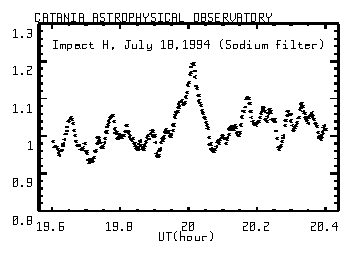

The plot shows, in a normalized scale, the flux measured with a photometer based on a Sodium Magneto-Optical Filter (SMOF) (Cacciani type), during the fragment H impact on July 18, 1994.
The SMOF consists of a sodium vapor cell in a magnetic field of about 1500 Gauss. It produces two narrow transmission bands (about 80 mA wide) formed by Zeeman splitting and Faraday rotation within the core of the neutral sodium resonance doublet at lambda 5890 & 5896 A.
Before entering the SMOF, 10% of theincoming light is picked-up by a beam splitter to simultaneously monitor the source and to accont for sky transparency and telescope tracking wiggles.
The photometer is fed by an optical fiber placed at the Cassegrain focus of the 61 cm telescope at Serra La Nave station of Catania Astrophysical Observatory.
The observations were made collecting the Jupiter light within a field of about 20 arcsec corresponding to the 600 micron diameter of the fiber, including the impact area.
The plot shows a clear enhancement of the sodium line flux of about 15-20%. The event started at 19:57 and ended at 20:04. It apparently occurred about 20 min after the impact, during the cooling phase of the plume.
The flash should mark the time of maximum population of neutral sodium in the first excited level i.e. a temperature,in the impact area (excitation temperature 5,000-10,000 K).
Submitted by Santo Catalano for the Catania group for the sodium filter observations.
scatalano@astrct.ct.astro.it